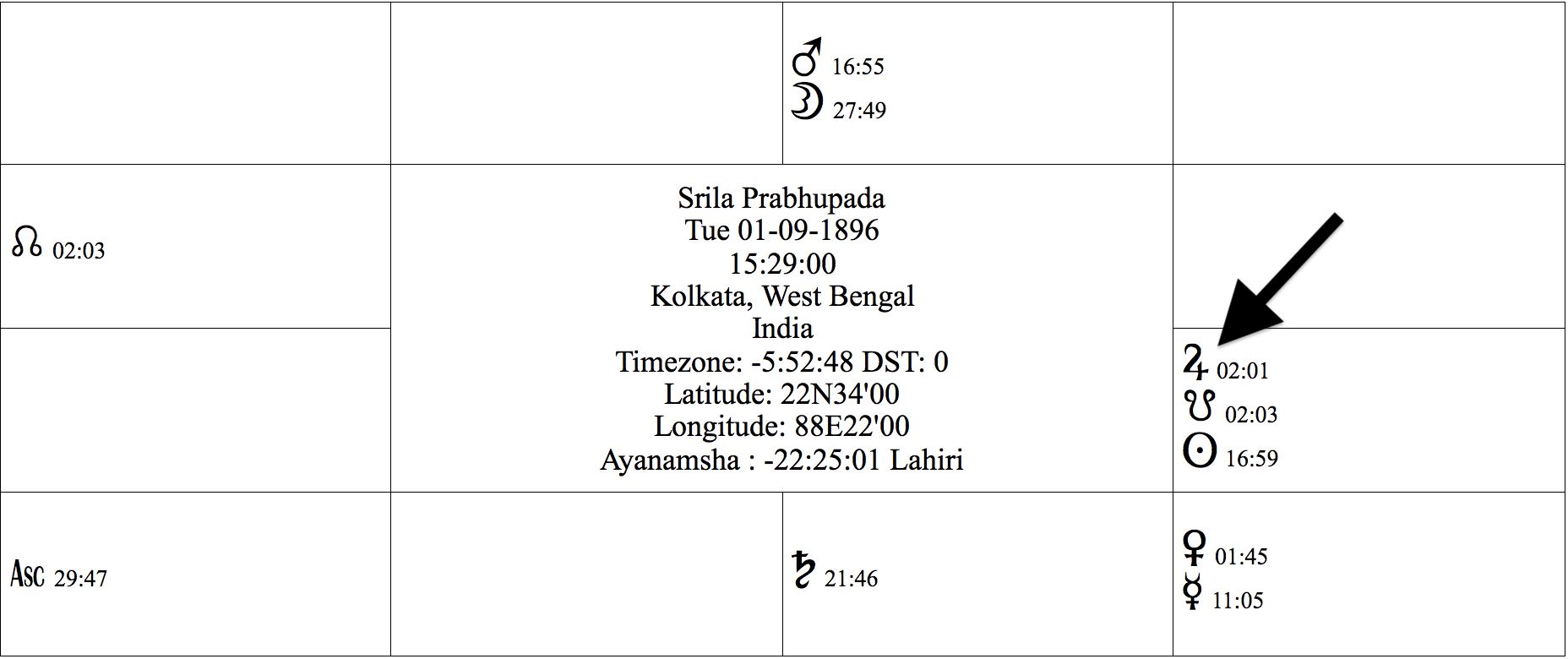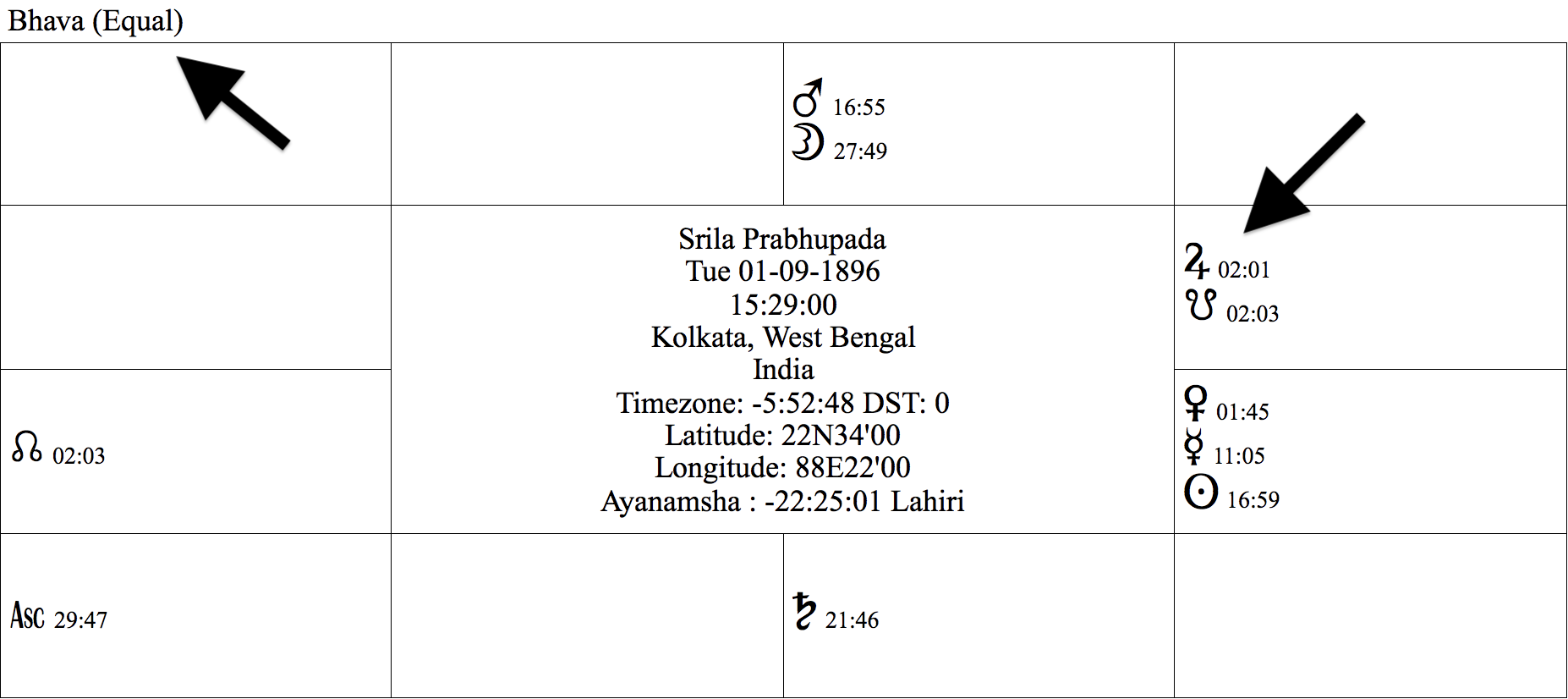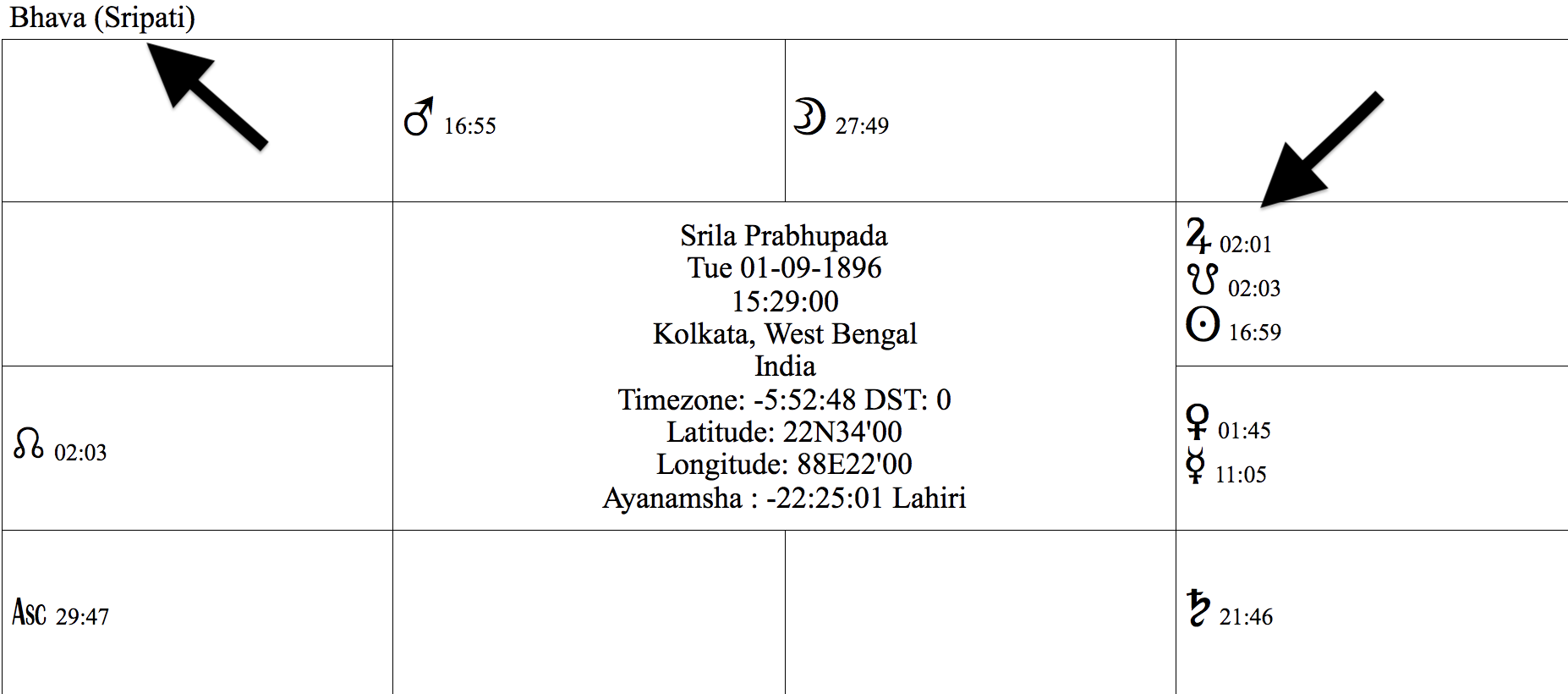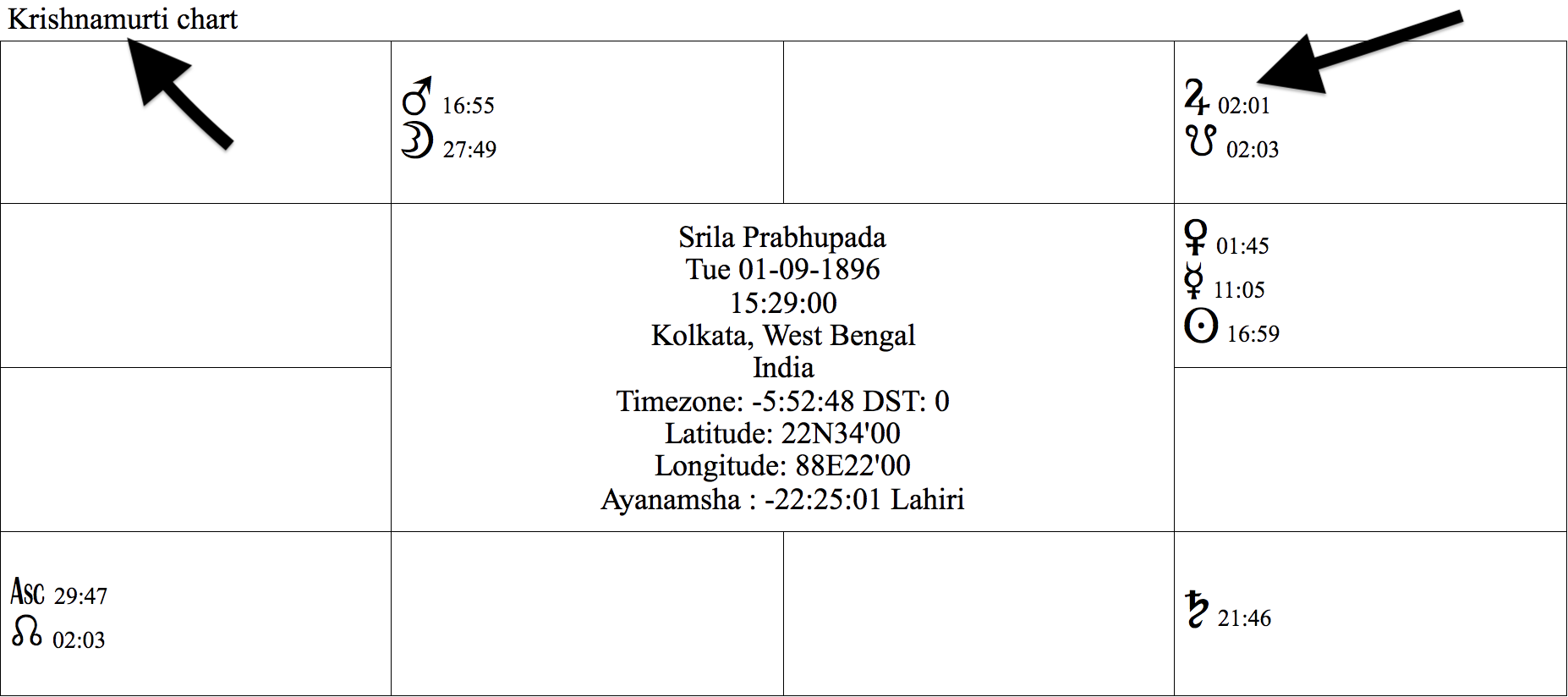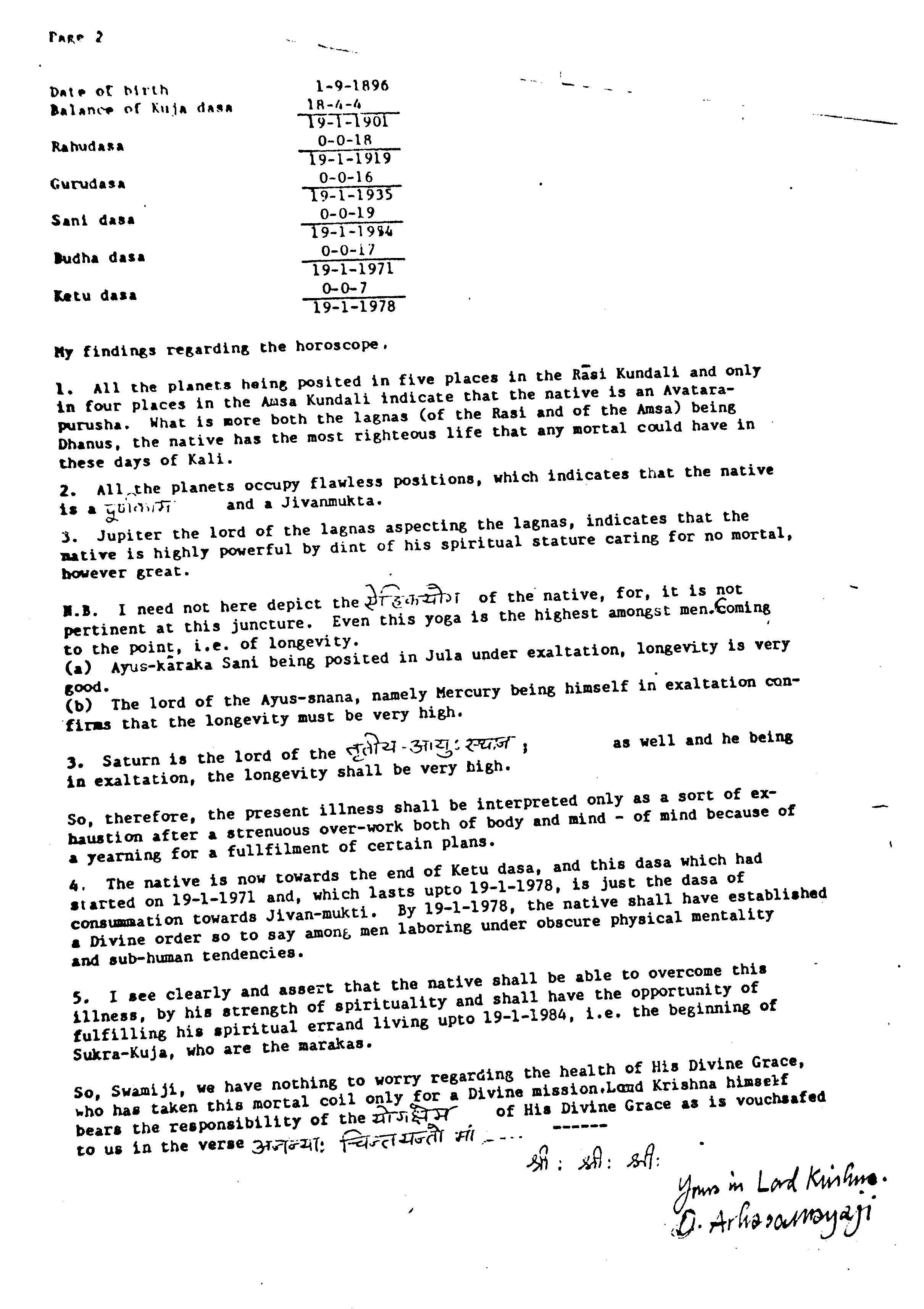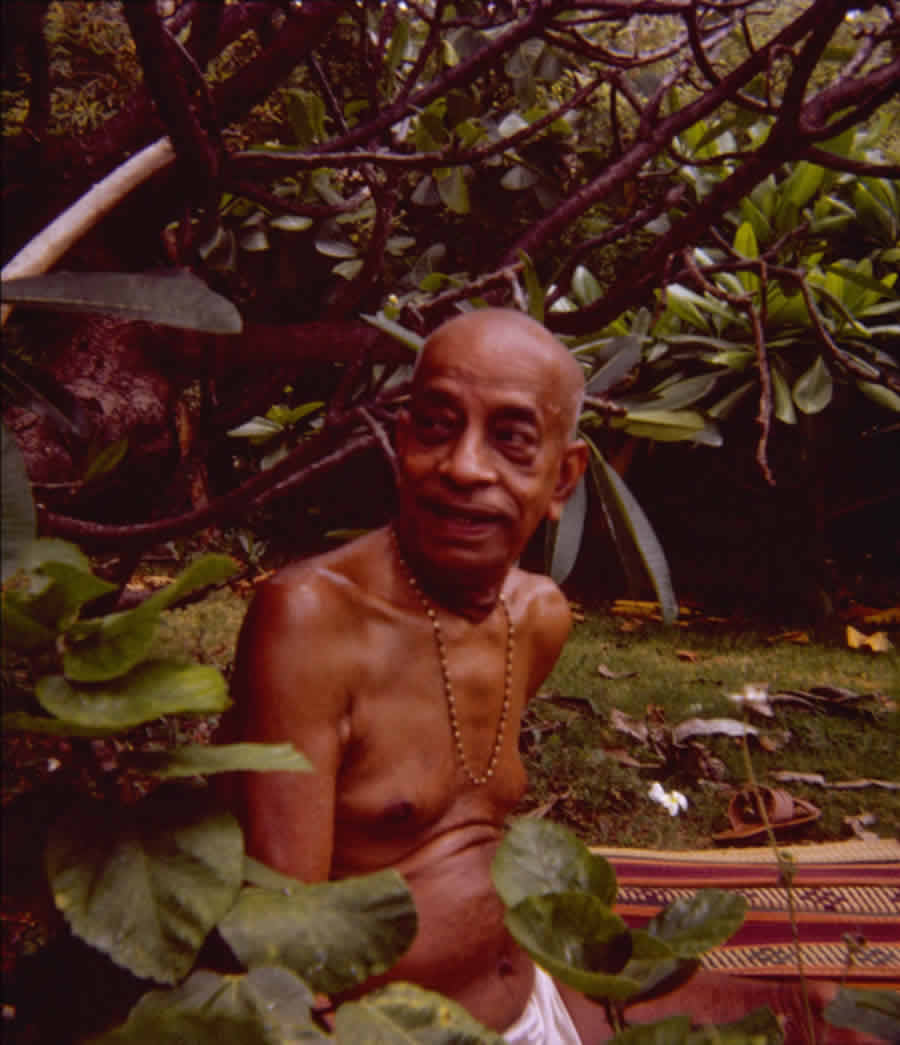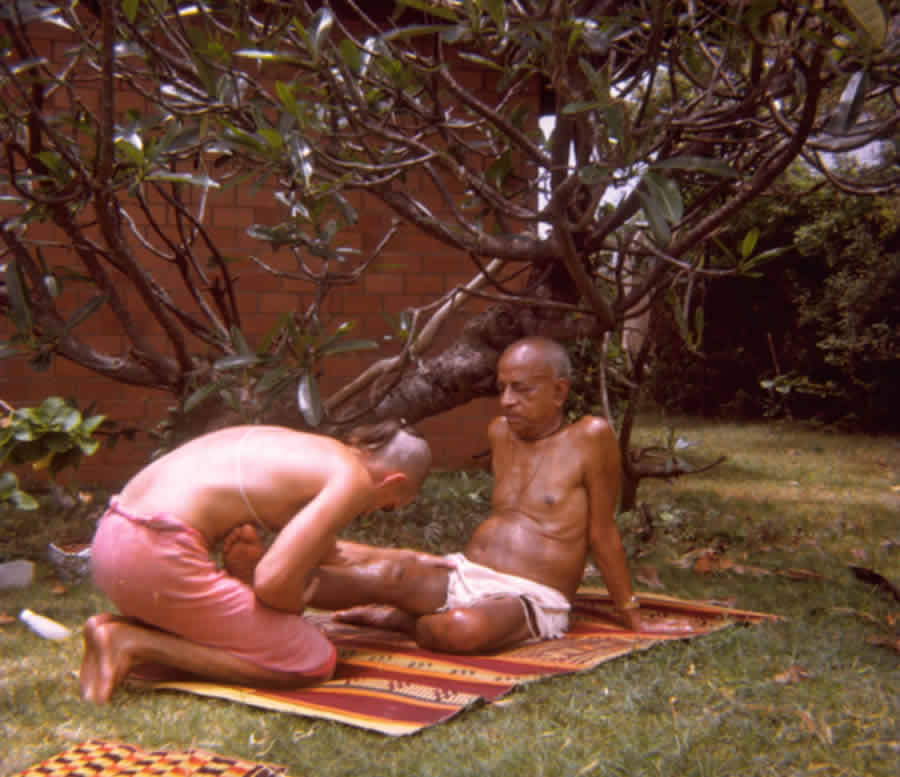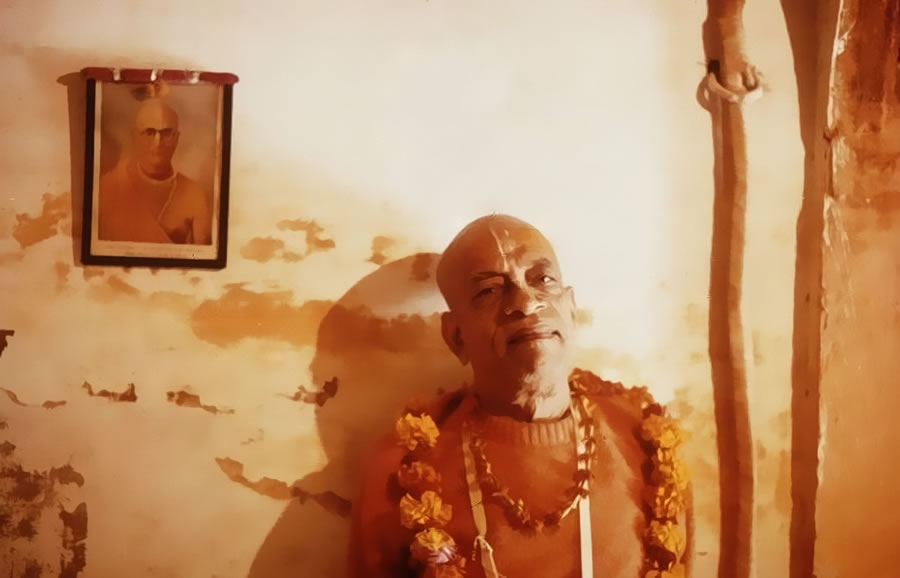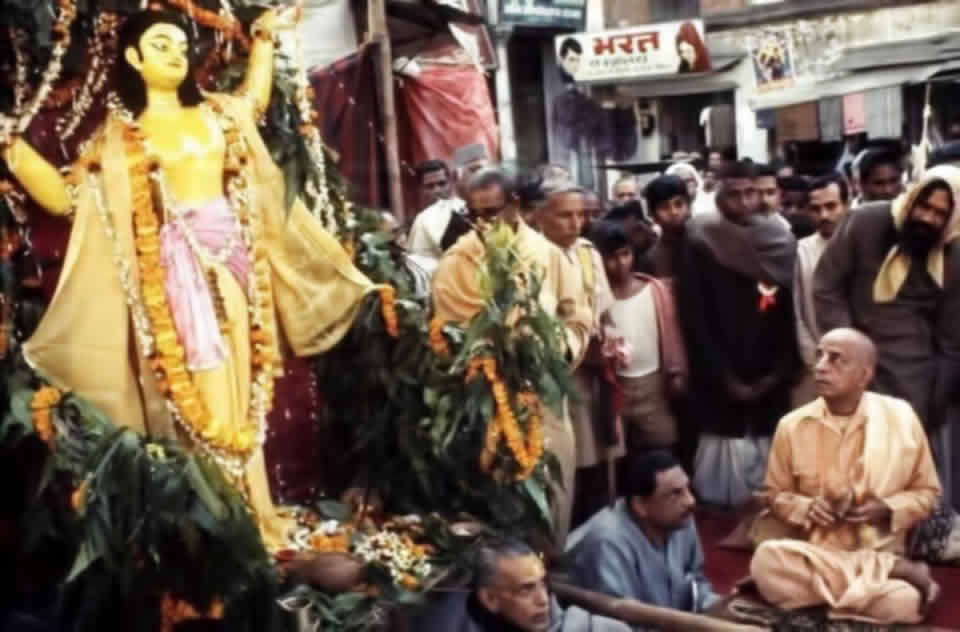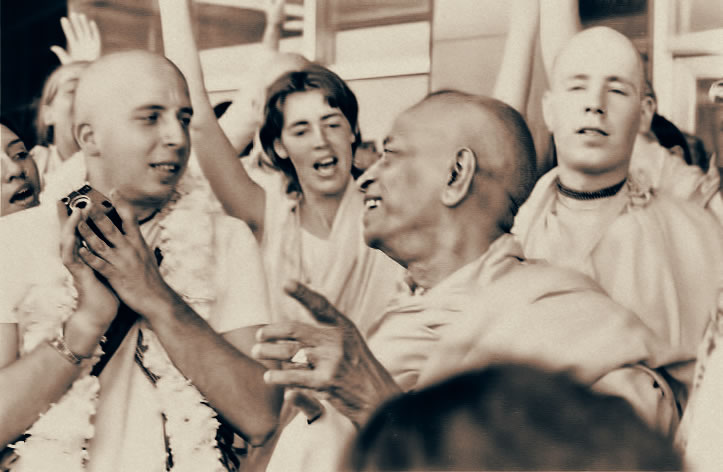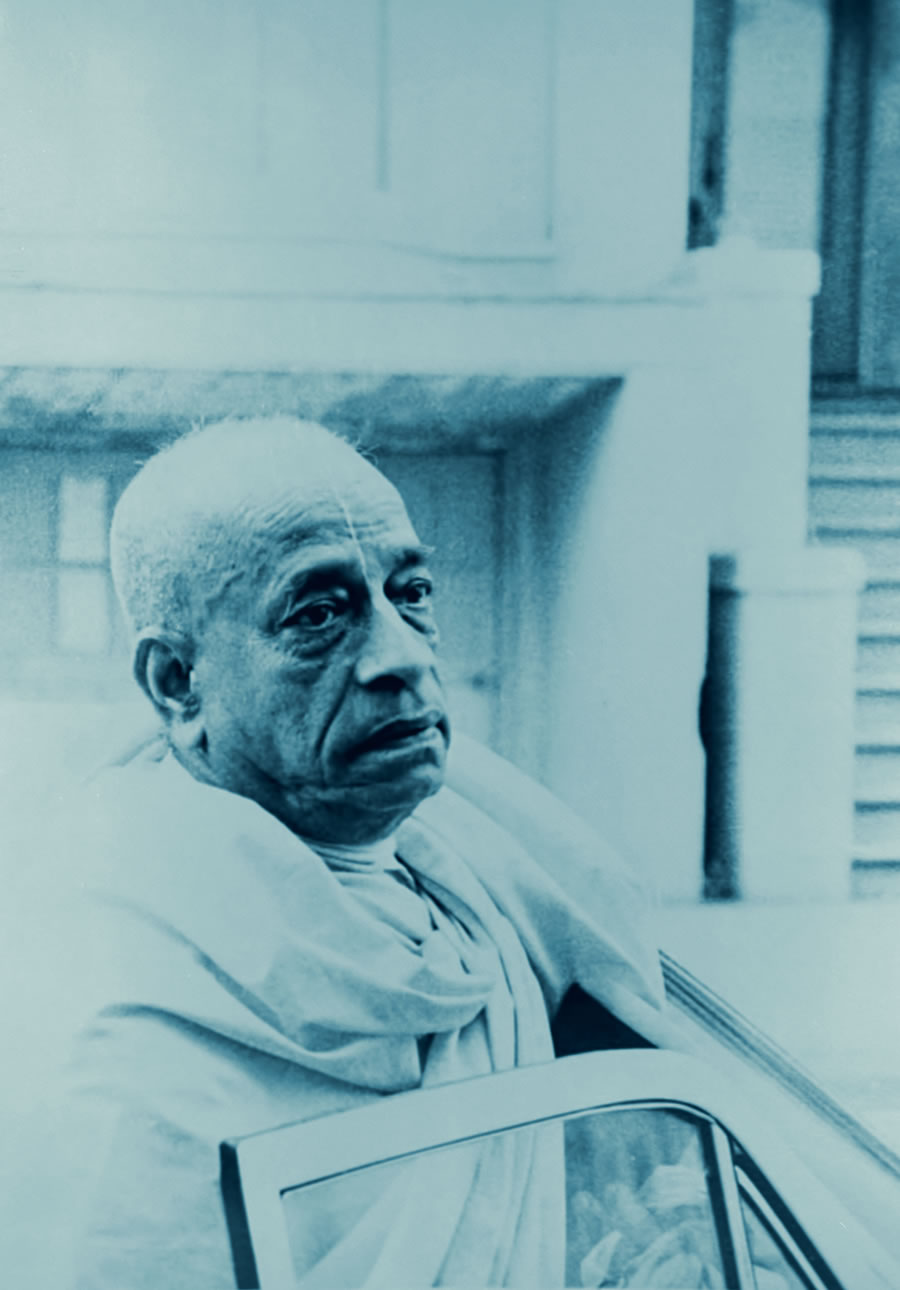Chapter 3
Analysis of Dhanus
Rising Chart
Page 6
1 2 3 4 5 6 7 8 9 10 11
3.0 Abstract
3.1 Concern for the Opinion of Astrologers
3.2 Dhanus Chart Weak Because of Rasi Sandhi
3.3 Numerous Astrologers Will Still Find Guru in the 8th
3.4 Candra-Mangala Yoga in the 6th
3.5 The Question of Longevity
3.6 Guru, Surya and Ketu in Simha
3.7 Sukra in the 10th
3.8 Sukra in Kanya
3.9 Conclusion
Abstract: The Dhanus chart has some interesting combinations. But when more closely examined, as astrologers often do for great personalities, they will find it essentially weak and flawed and not related to Srila Prabhupada. We demonstrate the weak position of the Dhanus Lagna placed in the Rasi-Sandhi (junction of two Signs). We show how some astrologers will still find Guru in the 8th house. We shall bring to the reader’s notice various combinations which indicate short, accident prone, sickly life. Show how the disturbed 5th house indicates: no sons and only daughters if any children at all; a person with an evil, sinful mind and suffering from mental diseases. Also how the disturbed 5th as well as afflicted Guru and Sukra in the 10th indicates megalomania and religious hypocrisy. In short the planets are not where they should be for a strong chart.
3.1 Concern for the Opinion
of Astrologers
Nalini Kanta Prabhu has practically claimed that Dhanus rising for Srila Prabhupada is a flawless chart which clearly indicates a pure devotee and perfectly describes Srila Prabhupada. Whereas he has only used unkind words to describe the Makara rising chart which Srila Prabhupada himself appears to have accepted as most correct (see 6.1 TKG’s letter ).
In this section we will examine the Dhanus horoscope. One of Nalini Kanta Prabhu’s arguments has been that:
... many others like myself will see the flaws in the horoscope [with Makara rising] and think less of Srila Prabhupada. (p. 5)
(For the opinion of some other astrologers see chapter 7.)He has made this statements many times in different ways, in an effort to influence people (inexperienced in astrology) into thinking that the Makara Rising chart is that of a “demonic karmi” whereas that of Dhanus Lagna is that of a “Saktyavesa avatara.” So far I have only shown the many positive aspects of the Makara chart; now let us turn to the Dhanus chart.
Certainly, the Dhanus rising chart has some very notable features, which might tempt us to think that this was Prabhupada’s chart. With a Dhanus rising the most notable features are Surya (the 9th lord) with Guru (lord of the Lagna itself, and the 4th house) in the 9th house of Dharma (9th house represents—dharma, guru, past pious activities, higher learning, good fortune, etc.). This is a very favorable position indicating lifelong good fortune, scholarship, travel overseas, happy life, good relations with father, religious tendencies, etc.
Budha exalted in the 10th causes Bhadra Mahapurusha Yoga which is very good and which Nalini has described on page three of his report. Rahu is also quite strong in the 3rd house giving courage, tenacity, cleverness, etc. And Kuja, a natural Malefic, seems well posited in the 6th house of enemies, obstacles, etc. With such positions we understand why someone, especially a beginning student in this science (Nalini Kanta, page 2) without much experience, would be mislead by this chart.
Let us now go a bit deeper, and as we do, the flaws will become glaring and we will see why this chart could not be that of Srila Prabhupada.
3.2 Dhanus Chart Weak
Because of Rasi Sandhi
First of all Nalini Kanta Prabhu, in order to keep the time of birth as close to Prabhupada’s stated time of birth (4:00 PM), has chosen 3:30 PM as the time of birth. When I calculated the chart on my computer with this time I was surprised to find that at 3:30 PM (LMT) 0 degrees of Makara (Lahiri Ayanamsa) was rising. This indicates how fragile this time of birth is. To actually get Dhanus we must go earlier than 3:30 PM to at least 3:29 PM. This puts the Lagna at 29°47' of Dhanus. This position of the Lagna is so close to the Sandhi—junction of Dhanus and Makara that it creates the flaw known as Rasi-Sandhi (emphasis mine):
There are four kinds of Sandhi viz. Rasi-sandhi, Rksa-sandhi, Tithi-sandhi and Dina-sandhi, whose effect is not happy.46
Rasi-Sandhi is a serious defect. Any planet or Lagna that falls at the junction place between two signs or two houses becomes useless:
If a planet, on the other hand, is posited in the same degree as the Sandhi, it should be put in the Sandhi and belongs to neither Bhava [house]. Such a planet is utterly ineffective in conferring good or bad results to the native. Please bear this important principle in mind for future guidance.47
The worst Rasi-sandhi is called Gandhanta and is caused when the Sandhi is at the junction of Mīna-Mesha, Kataka-Simha, and Vrscika-Dhanus. The reason being that not only is it the junction place of two signs but also of two Nakshatras. For example in the case of Mīna-Mesha it is also the junction of Revati-Asvini. The point being that having the Lagna placed at the last possible moment of Dhanus, as Nalini Kanta Prabhu has done, has introduced a very serious flaw into the horoscope making it very weak and “utterly ineffective”—like a riven cloud with no position in any sphere.
The strength derived from position is called Sthana-bala in Vedic astrology. Prabhupada’s chart, as depicted with a Dhanus Lagna suffers from the serious defect of the Lagna having no Sthana-bala because of being in the Rasi-sandhi, junction between two signs. And since the Lagna is of immense importance this is not a defect easily shrugged off. Since Nalini has speculated on the time of birth it might be argued that this serious flaw could be easily mended by pushing the time of birth back ten, fifteen or twenty minutes. As far back as necessary to change the Lagna and make it strong. This, however puts him between Scylla and Charybdis because now the time of birth is even farther away from 4:00PM, the time Prabhupada favored, than before—say 3:10PM or 3:15PM. This is not a very acceptable solution.
Let us, just for the sake of argument, accept that it is possible to push Prabhupada’s chart back without raising charges of gross speculation. Does that mean the chart is now free of serious flaws. No.
3.3 Numerous Astrologers Will
Still Find Guru in the 8th
A point to be considered is that Nalini Kanta is very concerned about the opinions of other astrologers. He should know that they would also note this negative Rasi-sandhi position. Also he should consider that not all astrologers in India use the Sign=House method of house division as we both do. (This is the most traditional method of house division as defined in Brhat Jataka 1.4.) Some use the Vedic Equal House while others use the Sripati system for house division. For example B.V. Raman states:
Classical writers like Sripati favor a determination of Bhavas on the lines given in the following paragraphs. In our humble experience extending for nearly 35 years the equal house system [Vedic Equal House] appears to yield more satisfactory results.48
Some “modernized” Indian astrologers even opt for Western house division such as Placidus. The followers of Krishnamurti Paddhati in India certainly use this system. The point being that there will be a substantial minority of astrologers, (some like B.V. Raman, are very well-known) who will use these other house systems. And these astrologers will find that for the chart that Nalini Kanta proposes Guru will still fall in the 8th house, except that, unlike being the 12th lord in the 8th which is good, it will be the Lagna lord in the 8th. This is not at all favorable unless very positively aspected. And, in Vedic Equal House system they will also find that Surya is not conjoined Guru who is in the 8th house, but is rather in the 9th house conjoined debilitated Sukra.
Srila Prabhupada’s chart displayed in different house systems according to the Dhanus Lagna chart favored by Nalini Kanta Prabhu.
Rasi=Bhava: Guru is in the 9th
Vedic Equal House: Guru is in the 8th
Sripati: Guru is in the 8th
Krishnamurti Paddhati: Guru is in the 7th!
The reason for this is as follows. (I will try to be as untechnical as possible.) In the traditional Sign=House system, the first house, and all subsequent houses in the chart, is determined by which ever sign the Lagna should happen to be in, irrespective of its degree in that sign. Thus if 29°47' Dhanus rises, then the whole of Dhanus is the first house, all of Makara is the 2nd, Kumbha 3rd, . . ., all of Simha the 9th, Kanya the 10th, and so on. But with the Vedic Equal House system and the other various unequal house systems such as Sripati and Placidus, the scenario changes drastically.
For example, with the next most traditional system, Vedic Equal House, we get the following result. By the simple rules of this system the houses are thus mathematically defined: Take the ascending degree (let X = ascending degree) and add plus or minus 15 degrees to it. Thus the definition of the first house will be “X” +/- 15 degrees.
In the case which Nalini presents the Lagna is 29SA47. Thus, by this Vedic Equal House system the first house would stretch from 14SA47 (Sagittarius 14°47') to 14CP47 (Capricorn 14°47'). The other houses are obtained by adding multiples of 30 to each. By this method the house positions change radically. Rahu is now in the 2nd, Kuja and Candra stay in the 6th, but Ketu and Guru go to the 8th; and Sun, Sukra, and Budha go to the 9th; with Sani staying in the 11th. This is not at all a good chart because the Lagna lord has now gone to the 8th house and is conjoined Ketu, a first-rate malefic.
And, as I said earlier, followers of Sripati Paddhati and others will get a similar result of having Guru, the Lagna lord, in the 8th house with malefic Ketu. This is what a significant minority of astrologers will see. (With Krishnamurti Paddhati Guru moves to the 7th!) Thus we see that it would be naive in the extreme to expect that all astrologers would view the Dhanus Lagna chart which Nalini has presented, in a favorable light. We thus must conclude that his argument based on the opinion of other astrologers agreeing with him is not as strong as he presents it to be.
If it were desired to change the Lagna, so that the Vedic Equal house structure would not place Guru in the 8th house we would again have to postulate a time of birth significantly before 3:30 PM say about 2:30 PM or even earlier. This puts us in the same dilemma as the solution for Rasi-sandhi, junction between two signs; having a time of birth even more distant from the one given by Srila Prabhupada.
For the sake of argument we will ignore the substantial minority of astrologers who do not follow the most traditional system of house division—Sign=House, and only discuss the chart drawn up by Nalini Kanta Prabhu.
3.4 Candra-Mangala Yoga in the 6th
Our colleague, Nalini Kanta Prabhu, has placed Moon (lord of the 8th) and Mangala (lord of the 5th and 12th) in Vrshabha (the 6th house) and considers this quite good.49 But is it?
Candra, alone, as lord of the 8th, is exalted in Vrshabha and does tolerably well here. And it is well-known that Kuja does well in the 6th. So this seems good. And considering that Kuja also rules the 12th this might be considered a Viparita Raja Yoga as well. But there are some serious problems with this combination that Nalini Kanta has overlooked and which indicate that this could not be Prabhupada’s chart. Let us now look into this.50
A natural malefic [in this case Kuja], where ever he may be, he will destroy the house he occupies. But in so doing his qualities [karaka—significations] will get improved by his contact with good houses. (Favorable houses for malefics are 3, 6 and 11. When dealing with diseases 6 also is unfavorable). Thus evil planets occupying these houses will give out good [according to their karaka—significations of the planet] in their Dasa periods.51
Thus, in the case of Kuja for a Dhanus chart of Prabhupada we get the following result: Because Kuja is strong in the 6th the significations of Kuja will be strengthen, they being: “courage, diseases, (younger) brothers (and sisters), lands, enemies, paternal relations, army, heroic deeds, power, contentions, cuts, wounds, fire, etc.”52 In this case we would expect that it would indicate a very brave and courageous man of a contentious nature. We, of course agree that Srila Prabhupada was a very brave and courageous person. So we do not differ here. But there is more.
The qualities of the 6th house get destroyed, that is, enemies, obstacles, etc. Except that (as seen in previous quote) illness will get increased and the person will have many illnesses and injuries through out life in general especially in regards to the part of the body ruled by the sign associated with the 6th house. In this case that sign is Vrshabha, which rules the face, so we should expect many illnesses, wounds, and scars in regards to the face. It is clear that Srila Prabhupada did not have any pockmarks, wounds, illnesses or scars in regards to his face or throat area. In general, especially considering the other malefic combinations found in this chart which we will shortly discuss, we would think that the person born with this chart would be very rash, hotheaded (Kuja-Moon) with many enemies and obstacles to over come. In so doing he would run many risks and suffer many injuries such as falls, burns, stabs, gunshot, high fevers, broken bones, infections, and so on.
Aside from this we must note the houses that Kuja rules (5th and 12th) and how they will be affected by Kuja being in the 6th. We are most of all concerned with his 5th lord rulership as it gets destroyed by being in the 6th especially in conjunction with Candra (lord of the 8th).
The 5th house stands for:
Intelligence, prudence, memory, power of discrimination, merit earned in previous births, capacity to advise, ministers, children and condition of mind.53
Texts such as Satyajatakam, Sanketanidhi, Parasara , etc. are in general agreement that the 5th lord in the 6th, especially conjoined the 8th lord, is not at all favorable for the portfolio of the 5th house. The effect of Candra as 8th lord is expressed thus:
With regards to ownership, 6th, 8th, and 12th alone are bad. The lords of these, wherever they may be, will destroy the Bhavas [Houses] they occupy or aspect. Here ‘lords’ means both subhas [natural benefics] and papas [natural malefics].54
While it doesn’t specifically say so, it would be correct to extrapolate and say that a similar destructive effect will be felt on the houses owned by any planet conjoined the 6th, 8th, or 12th lords. In this case Moon with Kuja adds to the destruction of the 5th house in the Dhanus chart. Thus we could expect that a person with such a chart, would have no sons, or they would all die at a young age, or there would only be girls, or they would have to adopt or purchase a son. The person would have poor intelligence, no discrimination, be unwise, evil-minded and probably suffer from some type of mental disease. Also since Kuja is conjoined the 8th lord, this strongly indicates a highly sexed individual addicted to illicit connections with women. This certainly doesn’t sound like Srila Prabhupada.
The problem with this Dhanus chart is that all the planets are not so well placed. Planets which rule trinal and quadrants should be in trines or quadrants or at least neutral houses. And planets that rule evil houses like the 6th, 8th and 12th should be in said houses. In the Dhanus rising chart this is sadly missing. While there are some good combinations, there are some major problem areas as we just mentioned. The lord of the 5th, Kuja, has gone to an evil house, the 6th. He would have been much better placed in the 1st, 2nd, 4th, 5th, 7th, 9th, 10th, 11th or even the 12th. The 12th, though bad, is in this case ruled by Kuja so there would have been minimum difficulties if any. Another badly placed planet is Sukra who rules the 6th and 11th. We shall discuss Sukra later.
3.5 The Question of Longevity
The Makara rising chart definitely shows longevity as the 8th house is fortified by Surya who owns the house, and a great benefic, Guru, being placed in it. Guru in this case shows peaceful death in holy place. But what of the Dhanus rising chart? It appears to me that there are many serious yogas in it which indicate only a medium life span at best and a short one is more likely. Let us look at them.
We have already noted the combination of Moon (lord of 8th) in the 6th, with Kuja (lord of 5th and 12th). Moon alone here would have been good for longevity as he is the lord of the 8th, the house of death/life and is his sign of exaltation. His well-being is important. But we see that the ruler of the 8th house is conjoined with a first-rate , natural malefic—Kuja. While Kuja, independent of other considerations, is good in the 6th, we must now consider the combination of Kuja — who is always a natural malefic and never loses that status — in conjunction with the 8th lord the Moon. This is not a good indication and definitely points to a sudden and violent death as is the nature of Kuja (as we outlined above). Not only death but a life comprised of a string of serious illnesses, fevers, accidents, and venereal complaints even before death. Of course in astrology we cannot put every thing on just one indicator. But there are more.
Sani, who for Dhanus rising, rules both the 2nd and 3rd, becomes a first-rate Maraka (death-inducing planet) and he is a natural malefic. He is directly aspecting the 8th house of death as well as the Lagna. While it is true that Sani is exalted, this doesn’t in any way eliminate his maraka quality. Sani is a killer par excellence.
What about Guru, the Lagna lord? Is he not aspecting the Lagna and thus protecting the life? While it is true that Guru does aspect the Lagna, it is not a very exact aspect. The Lagna is at 29°47' of Dhanus while Guru is at 2°1' of Simha. The aspect is off by almost 28°. To be considered a close aspect it should have been within 5° of being exact. That would have been very nice and protective, but in this case it is a very wide aspect—only shooting in the general direction, not close to the target.
Aside from this wide aspect, Guru, the Lagna lord is very closely conjoined by Ketu who is only 2 minutes of arc away at 2°3' of Simha. Ketu is a first-rate malefic considered to be of a similar incendiary nature as Kuja. This is a very serious affliction when considering longevity and physical and mental health in general making for an individual with either lifelong chronic illnesses or mental aberrations or both. And on top of this Kuja is also aspecting this combination of Guru and Ketu from the 6th house, which only adds fuel to the fire.
We now see that there are actually quite a few pointers showing that this chart is inherently weak regarding health and longevity. For even if the person were to somehow live long, the afflictions to the indicators of life and health are serious enough to indicate, if not short life, one constantly troubled with many serious mental and physical ailments and accidents, beyond the norm which the average person must under go (no one in the material world is free of afflictions) and which would seriously inhibit the person’s ability to function.
The objection may be raised that Arkasomayaji, the South Indian astrologer who did Srila Prabhupada’s chart with a Dhanus rising, said that Srila Prabhupada would live till he was 86-87 years old. This seems to contradict what I have said regarding the short longevity indicated by the Dhanus rising chart. Why would he predict such long life if it is not indicated in the chart? In reply we should like to say that Arkasomayaji did not think to consider these things because Prabhupada was there before him at 81 years of age, so what is the question of thinking that he should have died 20-30 years earlier. The mind would block out such considerations, or one might think that there were some yogas that were not readily visible that extended life.
We must also consider why he was so inaccurate in predicting death, whereas with Makara rising it was obvious. The reason being that for Dhanus rising there is actually little to suggest death at that time and for this reason Arkasomayaji predicted easy recovery and that death would take place only during the Sukra X Kuja period. He states on page two of his letter:
I see clearly and assert that he shall be able to overcome this illness, by his strength of spirituality and shall have the opportunity of fulfilling his spiritual errand living up to 19-1-84, i.e., the beginning of Sukra-kuja [Venus-Mars], who are the marakas [death inflicting].
Here Arkasomayaji confirms our contention that for this Dhanus rising chart Kuja is a maraka because he is a natural malefic placed in the 6th with Candra, the lord of the 8th which controls longevity. Sukra (see our discussion of Sukra further in this chapter) is also empowered to cause death because for Dhanus rising Sukra rules over the 6th house of disease, accidents, etc., which is also the place where Mars and the 8th lord Moon are sitting.
With the Makara chart the time of death becomes very evident because with Ketu period going on and Ketu in the 8th house of death and with Sani also transiting through this place death becomes a very serious possibility.
3.6 Guru, Surya and Ketu in Simha
Our colleague has touted the glories of Guru (lord of the 1st and 4th), Surya (lord of 9th) and Ketu, in Simha which is also the 9th house. We agree that for a Dhanus rising, Surya and Guru in Simha (the 9th) could be quite laudable. But there are potential problems.
To delineate the characteristics and personality from the chart we must see the position of both the Lagna and the Lord of the Lagna. The Lord of the Lagna, in this case Guru for a Dhanus Lagna, becomes the chart ruler. His position, condition and association etc., will determine to a great degree the quality of the chart. For a good, strong chart, the chart ruler should be in a favorable sign, house, and be in the association of benefics or be aspected by benefics. If the situation is otherwise then the effects are reverse, i.e. bad and weak chart indicating evil tendencies, poor health etc.
For a Dhanus Lagna chart the personality and character will be greatly colored by whatever sign Guru, the chart ruler, goes to as well as whatever planets may affect him in that position. Since Guru is located in Simha in this chart it means that the personality would be strongly influenced by Simha characteristics.
Unfortunately for the Dhanus chart the chart ruler, Guru, is seriously afflicted by an exact conjunction with Ketu who is a first-rate malefic. Ketu (depending on the situation) could have the tendency to twist and exaggerate what he comes in contact with. This could indicate that the less attractive Simha qualities would manifest in the person with such a combination. An afflicted Simha personality can be extremely egotistical, pompous, pretentious, aloof, snobbish, and all in all bombastically insufferable. They lack the ability to be introspective and humility is not a word found in their lexicon.
We should say that while it is true that Ketu is also known as Moksha-karaka and Jnana-karaka, the significator of liberation and knowledge, this is only so in special circumstances and cannot be blindly applied in all circumstances. Ketu signifies the following items:
Jnana, maternal grandfather, witch craft, heresy, agnosticism-atheism, cheating, sinful acts, imprisonment, backbiting, scandal-mongering, troubles through enemies, possession by demons and spirits, etc.55
Jataka Parijata 2.80 describes Ketu thusly:
Ketu indicates itches, measles, small-pox, troubles from enemies, low people, devils, diseases caused by past sins, trouble through rats, dogs, poisonous insects, fire, accidents, leprosy, etc.
Numerous other texts could be quoted but they would repeat the same litany. Ketu only represents Moksha and Jnana in rare cases, for the most part his portfolio is a roll call of miseries.
Having the chart ruler so acutely afflicted by Ketu severely flaws this Sagittarian chart. I have many charts of real people who have otherwise strong charts but whose chart ruler is afflicted by either Rahu or Ketu, and it has disastrous effects on them. These negative effects can be either on the mental or physical platform or both.
I suggest that for a Dhanus chart, having the chart ruler conjunct Ketu in Simha would only exaggerate the negative Simha tendencies which I previously described. It would also make the person susceptible to both serious physical and mental afflictions, especially considering the other afflictions to health that we have already mentioned.
But for a Makara rising chart the chart ruler is Sani. Sani is not at all afflicted but rather is very strong by being in his exaltation sign Tula, in the very strong 10th house forming a Sasa Mahapurusha Yoga and without malefic influence from other planets. For Makara, Ketu is still associated with Guru but in that case Guru is the 12th lord who is specifically related to spiritual attributes and is also known as the house of liberation. And both are in the 8th house, a house related to deep spiritual matters and categorized as a house of Moksha. Thus for Makara rising Guru and Ketu in the 8th indicate Moksha.
But for Dhanus rising Guru and Ketu in the 9th is a formula for disaster.
3.7 Sukra in the 10th
As we previously mentioned in relation to Kuja and Candra in the 6th house all the planets are not properly situated in a Dhanus rising chart. Here we will discuss about the position of Sukra. Sukra for a Dhanus rising chart is the lord of the 6th and 11th. Though he is a natural benefic he becomes a functional malefic because, as we have seen, the 6th house rulership is considered quite bad. So the best place to have Sukra for a Dhanus rising chart would be in the 6th, 8th, 12th, 11th and 4th. But we would want to avoid placing Sukra in other houses such as 1st, 7th, 9th, and 10th because these houses would be damaged by the 6th house rulership of Sukra.
Sukra in this Dhanus chart is placed in the 10th in Kanya. Sukra is debilitated in Kanya but this is canceled out by the existence of certain yogas. However these yogas do not cancel out the fact that Sukra rules the 6th house and is placed in the 10th with Budha (lord of the 7th and 10th). We remind the reader of the nature of the 6th lord:
With regards to ownership, 6th, 8th, and 12th alone are bad. The lords of these, wherever they may be, will destroy the Bhavas [Houses] they occupy or aspect. Here ‘lords’ means both subhas [natural benefics] and papas [natural malefics].56
And we repeat that while it doesn’t specifically say so, it would be correct to extrapolate and say that a similar destructive effect will be felt on the houses owned by any planet conjoined the 6th, 8th, or 12th lords.
This therefore suggests that from the position of Sukra in the 10th the significations of the 4th, 7th, and 10th become seriously disturbed. The 4th because Sukra aspects it. The 7th because Sukra is conjoined Budha (lord of the 7th and 10th) and the 10th because Sukra is in the 10th conjoined Budha (lord of the 7th and 10th). We are most of all concerned with the 10th house because this is the most important of the quadrant houses and it indicates the quality and power of a man’s actions and thus indicates his status in life.
B.V. Raman summarizes the opinions of many Sages regarding the effect of the 6th lord in the 10th house, (this is the case of the Dhanus rising chart). He states:
If fortified: sinful and destructive nature, poses as an orthodox and pious man but really unscrupulous in regard to religious matters. When the lord is weak: dismissal [incompetent, can’t hold a position],formidable enemies, low life or begging.57[Emphasis mine.]
Sukra is also the lord of the 11th for Dhanus rising so this must also be considered:
[11th lord in the 10th] The person prospers very well in his business and makes good profits. His elder brother will also help him in his business. He will earn some prize money for original contributions to the subject of his study or profession. Depending on the benefic or malefic nature of the planet he will earn through fair or foul means.58 [Considering the result from the 6th house effect we suggest that it would be from foul means.]
These two results, one very bad, the other rather materialistic, do not remind us in any way of Srila Prabhupada. We also note that even if Sukra (the 6th lord) was strong it still gives a bad result what to speak if it is weak. In a Dhanus chart Sukra in the 10th is quite negative, yet our respectable God-brother thinks that this placement is good and superior to that which would take place if it is a Makara rising chart.
Please note the significant difference that occurs. For Makara rising, Sukra rules the 5th and 10th houses. Both are good and Sukra thus becomes the Raja-yoga karaka—planet capable of uplifting a person to great heights. For Makara rising Sukra gets placed in the 9th house, a very good house and a suitable destination.
The effects of Sukra as the lord of the 5th in the 9th are:
He will become a teacher or preceptor. Renovates ancient temples, wells, choultries [dharmashalas—places of free lodging for pilgrims] and gardens. One of the sons [or disciples, 5th also stands for disciples] attains distinction as an author or orator. If the lord is afflicted, he will earn divine wrath and consequent destruction of fortune.59
The effects of Sukra as the lord of the 10th in the 9th are as follows:
The 10th lord in the 9th house makes the person a spiritual stalwart. He will be a beacon light to spiritual seekers if Guru aspects the 10th lord. If both benefics and malefics aspect the 10th lord, the person is generally fortunate and well-to-do. He follows a hereditary profession or that of a preacher, teacher or healer. The father of the person has a great influence on him. He will be a dutiful son and do many charitable deeds.60
The placement of Sukra for the Dhanus rising suggests a cheating guru. Whereas that of Sukra for Makara definitely describes Srila Prabhupada.
3.8 Sukra in Kanya
One final point that I would like to make is regarding the debilitation of Sukra. On the last page of his report our senior god-brother charges that having a Makara rising chart places Sukra the Yoga-karaka in debilitation in the 9th house. He states:
Not to speak of having the yogakaraka or planet which can give most potency, DEBILITATED in the 9th house of RELIGION (if Cap. rises). [Capitals his.]
He neglected to mention that for both Dhanus or Makara rising Sukra is debilitated in Kanya. But Sukra has received cancellations of debilitation (Nicabhanga Raja-yoga) (1) by his conjunction with exalted Budha, (2) because Guru is in the 4th house from Moon, (3) and because the lord of the navamsa that Sukra is in is himself in the 10th. (We get into more details on this later.) This is true for both Dhanus and Makara rising charts. But why does our respected, senior godbrother forget to mention this fact and only cast aspersions on Sukra in the Makara chart while praising it in the Dhanus chart?
He states for Dhanus chart:
Venus—has exalted neechabhanga Raja-Yoga in the 10th due to the conjunction with exalted Mercury. He was expert at playing harmonium and karatals, and in singing kirtan. Venus being in Virgo contributed to his freedom from lust and material enjoyments. Venus in the 10th naturally gives fame and reputation. Being in the 5th from the Moon gave him many disciples.61[Emphasis mine.]
We note that in regard to Sukra for the Dhanus chart above he forgot to mention the very negative effects of Sukra as lord of the 6th house which destroys the signification of the 10th house. Not only this but he totally avoids mentioning the good that Sukra does for the Makara chart. This, it seems to me, is not an accurate assessment of either chart. He gives the Sukra of Dhanus rising glories it is not due while casting imprecations and maledictions on Sukra of Makara rising. I would suggest that this appears to be a very unfair and biased way of presenting astrology in an attempt to win an argument.
3.9 Conclusion
While the Dhanus chart has some interesting combinations that might tempt one to attach undue importance to it as the chart of His Divine Grace Srila Prabhupada, when it is closely examined, as astrologers of the future most assuredly will in the case of a great personality’s horoscope, they will find it riddled with flaws that cannot be attached to the life and activities of Srila Prabhupada.
They will find that the chart with Dhanus rising has the defect of the Lagna being on the Rasi-sandhi (junction of two signs). And, depending on which house system they use they may even find that with a Dhanus rising Guru will still go to the 8th house, but as the chart ruler which is quite problematic. (Whereas for Makara Lagna, Guru as 12th lord in 8th is good).
They will also find that the combination of Kuja and Candra in the 6th indicates a sickly, accident prone person, with no sons only daughters, and he himself is a sinful, stupid wretch. The Dhanus chart also indicates many dangers to life and physical and mental health. And with afflicted chart lord Guru in Simha the person should be an ego-maniac of questionable motives.
And, Sukra in the 10th reveals that he is a religious hypocrite who feigns religion for profit motive.
These imperfections are apart from the major blemish of the Dhanus rising chart which is that it totally ignores the time that Srila Prabhupada gave as his birth time and with which he had several charts cast through out his life.
On the other hand the Capricorn rising chart is a very nice study of how all the planets fall in the proper houses according to their own natures and categories. And on examining the meaning of the planets in the Capricorn rising chart in an unbiased way we are able to see Srila Prabhupada. All this, along with the added blessing that it is not drawn up with a concocted time, but according to the time given by His Divine Grace himself. This is a strong indicator that the Capricorn rising chart is Srila Prabhupada’s actual horoscope.
Footnotes
Go to Bibliography
46 Bhat, p. 41. ↩
47 Ibid., p. 27. ↩
48 Raman, 1976, p. 95. ↩
49 AM, December, 1981, p. 902. ↩ (Read the whole article as a PDF.)
50 Based on principles of analysis outlined in Prasna Marga chapter 14, and Catechism of Astrology (vol 1) pp. 102-106. ↩
51 Raman, 1983, p. 103. ↩
52 Raman, S.K., p. 36. ↩
53 Raman, 1980a, p. 423. ↩
54 Raman, 1983, p. 103. ↩
55 Raman, S.K., p. 38. ↩
56 Raman, 1983, p. 103 ↩
57 Raman, 1979, pp. 265-266. ↩
58 Raman, 1980, p. 370. ↩
59 Raman, 1979, p. 223. ↩
60 Raman, 1980, p. 245. ↩
61 AM, December, 1981, p. 902. ↩ (Read the whole article as a PDF.)
